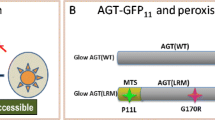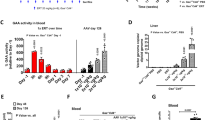Abstract
Defects in liver peroxisomal alanine:glyoxylate aminotransferase (AGT), as a consequence of inherited mutations on the AGXT gene, lead to primary hyperoxaluria type I (PH1), a rare metabolic disorder characterized by the formation of calcium oxalate stones at first in the urinary tract and then in the whole body. The curative treatments currently available for PH1 are pyridoxine therapy, effective in only 10–30 % of the patients, and liver transplantation, an invasive procedure with potentially serious complications. A valid therapeutic option for PH1 patients would be the development of an enzyme administration therapy. However, the exogenous administration of the missing AGT would require the crossing of the plasma membrane to deliver the protein to liver peroxisomes. In this study, we constructed, purified and characterized the fusion protein of AGT with the membrane-penetrating Tat peptide (Tat-AGT). Although Tat-AGT shows subtle active site conformational changes as compared with untagged AGT, it retains a significant transaminase activity. Western-blot analyses, enzymatic assays and immunofluorescence studies show that active Tat-AGT can be successfully delivered to a mammalian cellular model of PH1 consisting of chinese hamster ovary cells expressing glycolate oxidase (CHO-GO), whereas untagged AGT cannot. Moreover, the intracellular transduced Tat-AGT makes CHO-GO cells able to detoxify endogenously produced glyoxylate to an extent similar to that of CHO-GO cells stably expressing AGT. Altogether, these results show that the Tat peptide is capable of delivering a functional AGT to mammalian cells, thus paving the way for the possibility to use Tat-AGT as an enzyme replacement therapy to counteract PH1.




Similar content being viewed by others
Abbreviations
- PH1:
-
Primary hyperoxaluria type I
- AGT:
-
Alanine:glyoxylate aminotransferase
- PLP:
-
Pyridoxal 5′-phosphate
- CD:
-
Circular dichroism
- DLS:
-
Dynamic light scattering
- GO:
-
Glycolate oxidase
- CHO-GO:
-
Chinese hamster ovary cells expressing glycolate oxidase
- CHO-GO-AGT:
-
Chinese hamster ovary cells expressing glycolate oxidase and AGT
References
Behnam JT, Williams EL, Brink S, Rumsby G, Danpure CJ (2006) Reconstruction of human hepatocyte glyoxylate metabolic pathways in stably transformed Chinese-hamster ovary cells. Biochem J 394(Pt 2):409–416
Bertoldi M, Cellini B, Clausen T, Voltattorni CB (2002) Spectroscopic and kinetic analyses reveal the pyridoxal 5′-phosphate binding mode and the catalytic features of Treponema denticola cystalysin. Biochemistry 41(29):9153–9164
Caron NJ, Quenneville SP, Tremblay JP (2004) Endosome disruption enhances the functional nuclear delivery of Tat-fusion proteins. Biochem Biophys Res Commun 319(1):12–20. doi:10.1016/j.bbrc.2004.04.180
Cellini B, Bertoldi M, Montioli R, Paiardini A, Borri Voltattorni C (2007) Human wild-type alanine: glyoxylate aminotransferase and its naturally occurring G82E variant: functional properties and physiological implications. Biochem J 408(1):39–50. doi:10.1042/BJ20070637
Cellini B, Montioli R, Bianconi S, Lopez-Alonso JP, Voltattorni CB (2008) Construction, purification and characterization of untagged human liver alanine-glyoxylate aminotransferase expressed in Escherichia coli. Protein Pept Lett 15(2):153–159
Cellini B, Montioli R, Paiardini A, Lorenzetto A, Voltattorni CB (2009) Molecular insight into the synergism between the minor allele of human liver peroxisomal alanine:glyoxylate aminotransferase and the F152I mutation. J Biol Chem 284(13):8349–8358. doi:10.1074/jbc.M808965200
Cellini B, Lorenzetto A, Montioli R, Oppici E, Voltattorni CB (2010a) Human liver peroxisomal alanine:glyoxylate aminotransferase: different stability under chemical stress of the major allele, the minor allele, and its pathogenic G170R variant. Biochimie 92(12):1801–1811. doi:10.1016/j.biochi.2010.08.005
Cellini B, Montioli R, Paiardini A, Lorenzetto A, Maset F, Bellini T, Oppici E, Voltattorni CB (2010b) Molecular defects of the glycine 41 variants of alanine glyoxylate aminotransferase associated with primary hyperoxaluria type I. Proc Natl Acad Sci USA 107(7):2896–2901. doi:10.1073/pnas.0908565107
Cellini B, Oppici E, Paiardini A, Montioli R (2012) Molecular insights into primary hyperoxaluria type 1 pathogenesis. Front Biosci 17:621–634
Cochat P, Hulton SA, Acquaviva C, Danpure CJ, Daudon M, De Marchi M, Fargue S, Groothoff J, Harambat J, Hoppe B, Jamieson NV, Kemper MJ, Mandrile G, Marangella M, Picca S, Rumsby G, Salido E, Straub M, van Woerden CS, OxalEurope (2012) Primary hyperoxaluria Type 1: indications for screening and guidance for diagnosis and treatment. Nephrol Dial Transplant 27(5):1729–1736. doi:10.1093/ndt/gfs078
Coulter-Mackie MB, Lian Q (2006) Consequences of missense mutations for dimerization and turnover of alanine:glyoxylate aminotransferase: study of a spectrum of mutations. Mol Genet Metab 89(4):349–359
Coulter-Mackie MB, Lian Q (2008) Partial trypsin digestion as an indicator of mis-folding of mutant alanine:glyoxylate aminotransferase and chaperone effects of specific ligands. Study of a spectrum of missense mutants. Mol Genet Metab 94(3):368–374
Coulter-Mackie MB, Lian Q, Applegarth DA, Toone J, Waters PJ, Vallance H (2008) Mutation-based diagnostic testing for primary hyperoxaluria type 1: survey of results. Clin Biochem 41(7–8):598–602. doi:10.1016/j.clinbiochem.2008.01.018
Daidone F, Montioli R, Paiardini A, Cellini B, Macchiarulo A, Giardina G, Bossa F, Borri Voltattorni C (2012) Identification by virtual screening and in vitro testing of human DOPA decarboxylase inhibitors. PLoS One 7(2):e31610. doi:10.1371/journal.pone.0031610
Danpure CJ (2005) Molecular etiology of primary hyperoxaluria type 1: new directions for treatment. Am J Nephrol 25(3):303–310
Danpure CJ, Jennings PR (1986) Peroxisomal alanine:glyoxylate aminotransferase deficiency in primary hyperoxaluria type I. FEBS Lett 201(1):20–24
Danpure CJ, Cooper PJ, Wise PJ, Jennings PR (1989) An enzyme trafficking defect in two patients with primary hyperoxaluria type 1: peroxisomal alanine/glyoxylate aminotransferase rerouted to mitochondria. J Cell Biol 108(4):1345–1352
Danpure CJ, Jennings PR, Fryer P, Purdue PE, Allsop J (1994) Primary hyperoxaluria type 1: genotypic and phenotypic heterogeneity. J Inherit Metab Dis 17(4):487–499
Deegan PB (2012) Fabry disease, enzyme replacement therapy and the significance of antibody responses. J Inherit Metab Dis 35(2):227–243. doi:10.1007/s10545-011-9400-y
di Salvo ML, Safo MK, Contestabile R (2012) Biomedical aspects of pyridoxal 5′-phosphate availability. Front Biosci (Elite Ed) 4:897–913
Ferreira GC (1993) Erythroid 5-aminolevulinate synthase and X-linked sideroblastic anemia. J Fla Med Assoc 80(7):481–483
Fittipaldi A, Giacca M (2005) Transcellular protein transduction using the Tat protein of HIV-1. Adv Drug Deliv Rev 57(4):597–608. doi:10.1016/j.addr.2004.10.011
Fittipaldi A, Ferrari A, Zoppe M, Arcangeli C, Pellegrini V, Beltram F, Giacca M (2003) Cell membrane lipid rafts mediate caveolar endocytosis of HIV-1 Tat fusion proteins. J Biol Chem 278(36):34141–34149. doi:10.1074/jbc.M303045200
Fodor K, Wolf J, Erdmann R, Schliebs W, Wilmanns M (2012) Molecular requirements for peroxisomal targeting of alanine-glyoxylate aminotransferase as an essential determinant in primary hyperoxaluria type 1. PLoS Biol 10(4):e1001309. doi:10.1371/journal.pbio.1001309
Giardina G, Montioli R, Gianni S, Cellini B, Paiardini A, Voltattorni CB, Cutruzzola F (2011) Open conformation of human DOPA decarboxylase reveals the mechanism of PLP addition to Group II decarboxylases. Proc Natl Acad Sci USA 108(51):20514–20519. doi:10.1073/pnas.1111456108
Gump JM, Dowdy SF (2007) TAT transduction: the molecular mechanism and therapeutic prospects. Trends Mol Med 13(10):443–448. doi:10.1016/j.molmed.2007.08.002
Hopper ED, Pittman AM, Fitzgerald MC, Tucker CL (2008) In vivo and in vitro examination of stability of primary hyperoxaluria-associated human alanine:glyoxylate aminotransferase. J Biol Chem 283(45):30493–30502
Humbert O, Davis L, Maizels N (2012) Targeted gene therapies: tools, applications, optimization. Crit Rev Biochem Mol Biol 47(3):264–281. doi:10.3109/10409238.2012.658112
Lumb MJ, Danpure CJ (2000) Functional synergism between the most common polymorphism in human alanine:glyoxylate aminotransferase and four of the most common disease-causing mutations. J Biol Chem 275(46):36415–36422
Mdluli K, Booth MP, Brady RL, Rumsby G (2005) A preliminary account of the properties of recombinant human glyoxylate reductase (GRHPR), LDHA and LDHB with glyoxylate, and their potential roles in its metabolism. Biochim Biophys Acta 1753(2):209–216. doi:10.1016/j.bbapap.2005.08.004
Monico CG, Olson JB, Milliner DS (2005) Implications of genotype and enzyme phenotype in pyridoxine response of patients with type I primary hyperoxaluria. Am J Nephrol 25(2):183–188
Montioli R, Cellini B, Borri Voltattorni C (2011) Molecular insights into the pathogenicity of variants associated with the aromatic amino acid decarboxylase deficiency. J Inherit Metab Dis 34(6):1213–1224. doi:10.1007/s10545-011-9340-6
Montioli R, Fargue S, Lewin J, Zamparelli C, Danpure CJ, Borri Voltattorni C, Cellini B (2012) The N-terminal extension is essential for the formation of the active dimeric structure of liver peroxisomal alanine:glyoxylate aminotransferase. Int J Biochem Cell Biol 44(3):536–546. doi:10.1016/j.biocel.2011.12.007
Motley A, Lumb MJ, Oatey PB, Jennings PR, De Zoysa PA, Wanders RJ, Tabak HF, Danpure CJ (1995) Mammalian alanine/glyoxylate aminotransferase 1 is imported into peroxisomes via the PTS1 translocation pathway. Increased degeneracy and context specificity of the mammalian PTS1 motif and implications for the peroxisome-to-mitochondrion mistargeting of AGT in primary hyperoxaluria type 1. J Cell Biol 131(1):95–109
Muller IB, Wu F, Bergmann B, Knockel J, Walter RD, Gehring H, Wrenger C (2009) Poisoning pyridoxal 5-phosphate-dependent enzymes: a new strategy to target the malaria parasite Plasmodium falciparum. PLoS One 4(2):e4406. doi:10.1371/journal.pone.0004406
Oppici E, Montioli R, Lorenzetto A, Bianconi S, Borri Voltattorni C, Cellini B (2012) Biochemical analyses are instrumental in identifying the impact of mutations on holo and/or apo-forms and on the region(s) of alanine:glyoxylate aminotransferase variants associated with primary hyperoxaluria type I. Mol Genet Metab 105(1):132–140. doi:10.1016/j.ymgme.2011.09.033
Pegg AE, Shantz LM, Coleman CS (1995) Ornithine decarboxylase as a target for chemoprevention. J Cell Biochem Suppl 22:132–138
Pittman AM, Lage MD, Poltoratsky V, Vrana JD, Paiardini A, Roncador A, Cellini B, Hughes RM, Tucker CL (2012) Rapid profiling of disease alleles using a tunable reporter of protein misfolding. Genetics. doi:10.1534/genetics.112.143750
Rapoport M, Salman L, Sabag O, Patel MS, Lorberboum-Galski H (2011) Successful TAT-mediated enzyme replacement therapy in a mouse model of mitochondrial E3 deficiency. J Mol Med (Berl) 89(2):161–170. doi:10.1007/s00109-010-0693-3
Ringe D, Petsko GA (2009) What are pharmacological chaperones and why are they interesting? J Biol 8(9):80
Rucktaschel R, Girzalsky W, Erdmann R (2011) Protein import machineries of peroxisomes. Biochim Biophys Acta 1808(3):892–900. doi:10.1016/j.bbamem.2010.07.020
Salido EC, Li XM, Lu Y, Wang X, Santana A, Roy-Chowdhury N, Torres A, Shapiro LJ, Roy-Chowdhury J (2006) Alanine-glyoxylate aminotransferase-deficient mice, a model for primary hyperoxaluria that responds to adenoviral gene transfer. Proc Natl Acad Sci USA 103(48):18249–18254
Schwarze SR, Ho A, Vocero-Akbani A, Dowdy SF (1999) In vivo protein transduction: delivery of a biologically active protein into the mouse. Science 285(5433):1569–1572
Sloots A, Wels WS (2005) Recombinant derivatives of the human high-mobility group protein HMGB2 mediate efficient nonviral gene delivery. FEBS J 272(16):4221–4236. doi:10.1111/j.1742-4658.2005.04834.x
Toro A, Grunebaum E (2006) TAT-mediated intracellular delivery of purine nucleoside phosphorylase corrects its deficiency in mice. J Clin Invest 116(10):2717–2726. doi:10.1172/JCI25052
Toro A, Paiva M, Ackerley C, Grunebaum E (2006) Intracellular delivery of purine nucleoside phosphorylase (PNP) fused to protein transduction domain corrects PNP deficiency in vitro. Cell Immunol 240(2):107–115. doi:10.1016/j.cellimm.2006.07.003
van den Berg A, Dowdy SF (2011) Protein transduction domain delivery of therapeutic macromolecules. Curr Opin Biotechnol 22(6):888–893. doi:10.1016/j.copbio.2011.03.008
Vyas PM, Tomamichel WJ, Pride PM, Babbey CM, Wang Q, Mercier J, Martin EM, Payne RM (2012) A TAT-frataxin fusion protein increases lifespan and cardiac function in a conditional Friedreich’s ataxia mouse model. Hum Mol Genet 21(6):1230–1247. doi:10.1093/hmg/ddr554
Williams EL, Acquaviva C, Amoroso A, Chevalier F, Coulter-Mackie M, Monico CG, Giachino D, Owen T, Robbiano A, Salido E, Waterham H, Rumsby G (2009) Primary hyperoxaluria type 1: update and additional mutation analysis of the AGXT gene. Hum Mutat 30:910–917
Wu F, Christen P, Gehring H (2011) A novel approach to inhibit intracellular vitamin B6-dependent enzymes: proof of principle with human and plasmodium ornithine decarboxylase and human histidine decarboxylase. FASEB J 25(7):2109–2122. doi:10.1096/fj.10-174383
Zhang X, Roe SM, Hou Y, Bartlam M, Rao Z, Pearl LH, Danpure CJ (2003) Crystal structure of alanine:glyoxylate aminotransferase and the relationship between genotype and enzymatic phenotype in primary hyperoxaluria type 1. J Mol Biol 331(3):643–652
Zhu W, Lin A, Banerjee R (2008) Kinetic properties of polymorphic variants and pathogenic mutants in human cystathionine gamma-lyase. Biochemistry 47(23):6226–6232. doi:10.1021/bi800351a
Acknowledgments
This work was supported by the Telethon Foundation (Grant No. GGP 10092).
Conflict of interest
The authors declare that they have no conflict of interest.
Author information
Authors and Affiliations
Corresponding author
Electronic supplementary material
Below is the link to the electronic supplementary material.
Rights and permissions
About this article
Cite this article
Roncador, A., Oppici, E., Montioli, R. et al. TAT-Mediated Delivery of Human Alanine:Glyoxylate Aminotransferase in a Cellular Model of Primary Hyperoxaluria Type I. Int J Pept Res Ther 19, 175–184 (2013). https://doi.org/10.1007/s10989-012-9333-9
Accepted:
Published:
Issue Date:
DOI: https://doi.org/10.1007/s10989-012-9333-9




